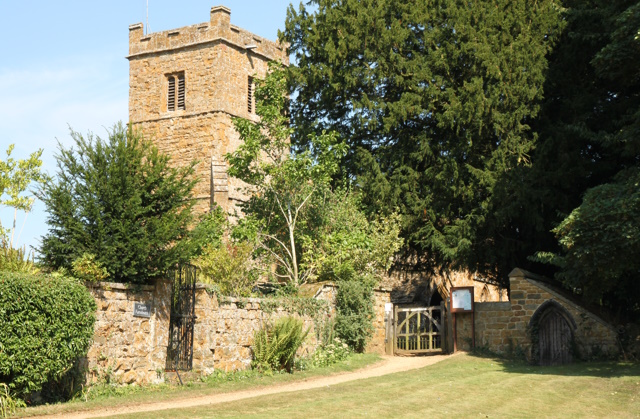


























All Saints Church, Mollington
All Saints Church in Mollington consists of a chancel, nave, north aisle, south porch, and west tower. The chancel and nave were built in the 14th century, the only feature of an earlier date being the font, which is decorated with dog-tooth ornament of the 13th century. The west tower was built c. 1500. The north aisle was rebuilt in 1855 on the site of an aisle that existed by the early 14th century; it is separated from the nave by an arcade of four bays, above which is a clerestory of two two-light windows. On the north side of the chancel a blocked arch indicates the existence of a former north chapel, whose piscina survives in what is now the outside wall. An adjoining doorway, also blocked, presumably gave access to a vestry. In 1715 the churchwardens reported that they had pulled down the porch and were rebuilding it: it was evidently reconstructed with the old materials, as its features are all characteristic of the 14th century. In 1786 the north aisle and chapel were 'taken down' or dismantled, the arcades were built up, and for seventy years the church consisted only of nave, chancel, and tower. In 1855 the nave was restored and the north aisle rebuilt by G. E. Street. A gallery was removed, and the 15th-century chancel screen of crudely carved wood was placed beneath the tower arch. Though the repair of the chancel was considered in 1854, nothing was done until 1922, when its masonry was restored. The roofs of both nave and chancel were releaded in 1929, and extensive repairs to the timbers were carried out in 1965. Electric light was installed in 1953, and electric heaters in 1958. There are tablets to the memory of Anthony Woodhull and his wife Mary (both d. 1669) and of Elizabeth Woodhull (d. 1657). In the chancel are brass inscriptions to the same Anthony and Mary Woodhull, Anthony Woodhull (d. 1675), and his wife Ann (d. 1678), and Francis Woodhull (d. 1700). There are memorials to various members of the Holbech family, namely Ambrose the elder (d. 1701) and the younger (d. 1737), Elizabeth (née Woodhull, d. 1732), wife of Hugh Holbech, Hugh's sister Finetta (d. 1758), another Hugh Holbech (d. 1763) and his wife Catherine (d. 1753). The glass in the east window (1877) commemorates Harriet Mavor. The bells were reported as unsatisfactory in 1868; the ring of five dates from 1631, 1789, and 1875, when the treble and second were added and the tenor recast; there is, in addition, a sanctus. The bells hang in an 18th-century oak frame. The church clock is a two-train striker, dating from the late 17th or early 18th century; its anchor escapement has been modified in the same way, and probably by the same smith as that of the original Cropredy clock, now at Horley. The organ is by T. C. Bates & Son, Ludgate Hill. The church plate, which is modern, includes a silver chalice and paten made by John Keith in 1852 and bought in 1855. The Holbeches gave land for small additions to the churchyard in 1891 and 1908. The rent of an allotment of under 1 a., assigned at inclosure in 1796 to the repair of the church, was still creditied in 1966 to the church account. In 1909 Jeremiah French gave allotments, and Mrs. Hyems £20, for the repair of the church; the charities were amalgamated by 1927. The registers begin in 1561; there are no entries for the period 1614–16 and few for the Civil War period. Historical information about All Saints Church is provided by Christina Colvin, Janet Cooper, N H Cooper, P D A Harvey, Marjory Hollings, Judith Hook, Mary Jessup, Mary D Lobel, J F A Mason, B S Trinder and Hilary Turner, 'Parishes: Mollington', in A History of the County of Oxford: Volume 10, Banbury Hundred, ed. Alan Crossley (London, 1972), pp. 197-206. British History Online http://www.british-history.ac.uk/vch/oxon/vol10/pp197-206 [accessed 19 February 2023]. St. Michael's Church is a Grade II* listed building. For more information about the listing see CHURCH OF ALL SAINTS, Mollington - 1228026 | Historic England. For more information about St. Michael's Church see Parishes: Mollington | British History Online (british-history.ac.uk). |

